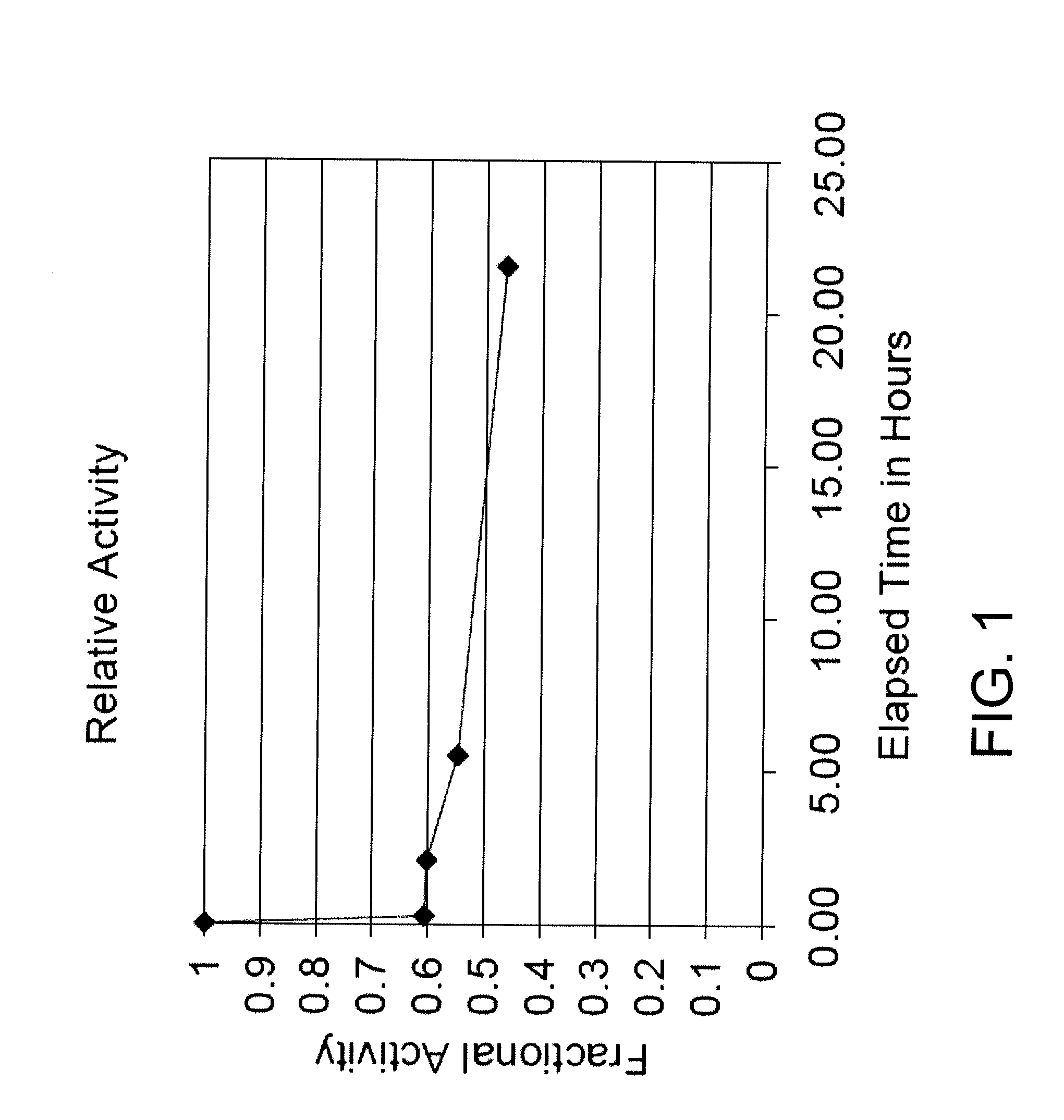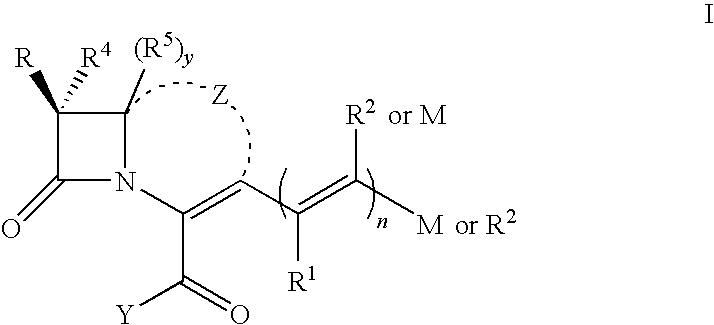Broad spectrum beta-lactamase inhibitors
a beta-lactamase, broad-spectrum technology, applied in the direction of biocide, antibacterial agent, drug composition, etc., can solve the problems of little intrinsic antimicrobial activity, not clinically effective at inhibiting classes b, c, and antibiotic resistance has become a major problem worldwide, and achieve the effect of improving antibiotic activity
- Summary
- Abstract
- Description
- Claims
- Application Information
AI Technical Summary
Benefits of technology
Problems solved by technology
Method used
Image
Examples
example 1
Assay (I) for Beta-Lactamase Activity
[0161]A chromogenic cephalosporin, Cefesone, is synthesized and isolated as described by Sutton et al. and used to monitor p-lactamase activity. A typical assay monitors the hydrolysis of Cefesone via the formation of a species which absorbs at 486 nm (molar absorptivity constant 16,000). Absorption is monitored as a function of time in 0.1 M, pH 7.0 sodium phosphate, 0.2 mM Cefesone and 4 volume percent DMSO cosolvent at 30° C. using a Beckman DU-40 spectrophotometer having a circulating water bath attached to the cuvette holder. The assay is initiated by addition and mixing of an appropriate amount of beta-lactamase.
[0162]Assay (II) for Beta-Lactamase Activity
[0163]Another method of monitoring for beta-lactamase activity involved dissolving enough Cefesone in ethyl acetate to make a solution of 3 micrograms per microliter. Ten microliters of this solution is then applied to a 6 mm diffusion disc. To monitor activity, the disc is dampened with w...
example 2
[0164]The following example is directed to synthesis of compounds of one preferred subset of compounds of formula I, those having a cephem nucleus and an M group having a cyclopropane ring (XX):
[0165]where variables are as defined in various formulas above. The method applies more specifically to compounds of formula XX where R is R′— NH—, an amine, where in formula XX, R′ most generally R is a proton or a pharmacologically acceptable functional group or salt, each R1, R2, each R″, R6 and R7, independently, are selected from hydrogens, halogens or organic functional groups, including alkyl functionalized carbonyl, esters, carbamates, and other electron withdrawing groups. The method more specifically applies to compounds of formula XX where each R″, R6, and R7 are selected from the group consisting of hydrogen, halogens, carbonyl groups, alkylcarbonyl groups, alkoxycarbonyl groups, aromatic carbonyl groups, carboxylate esters, aromatic carboxylic esters, primary, secondary, and tert...
example 3
Product Inhibition of Beta-Lactamase
[0173]The beta-lactamase assay using enzyme fro Enterobacter cloacae (Sigma-Aldrich, St. Louis, Mo.) was carried out as in Example 1 (assay 1) above with compound 2. After the initial rate was determined the reaction was allowed to continue for two hours. Theoretical maximal absorbance at 486 nm is approximately 1.6 while the observed final absorbance was consistently 0.26. This result is consistent with product inhibition as illustrated by the following equation:
[0174]where E is enzyme, S is substrate, P is product, ES is the enzyme-substrate complex, EP is the enzyme product complex, and k1, k-1, k2, and k12 are rate constants and kcat is the catalytic rate constant. In the case of product inhibition k12 is large with respect to k2, so as enzyme product accumulates, more enzyme is tied up in the enzyme-product complex and is unavailable for catalysis.
PUM
| Property | Measurement | Unit |
|---|---|---|
| Structure | aaaaa | aaaaa |
| Antimicrobial properties | aaaaa | aaaaa |
Abstract
Description
Claims
Application Information
 Login to View More
Login to View More - R&D
- Intellectual Property
- Life Sciences
- Materials
- Tech Scout
- Unparalleled Data Quality
- Higher Quality Content
- 60% Fewer Hallucinations
Browse by: Latest US Patents, China's latest patents, Technical Efficacy Thesaurus, Application Domain, Technology Topic, Popular Technical Reports.
© 2025 PatSnap. All rights reserved.Legal|Privacy policy|Modern Slavery Act Transparency Statement|Sitemap|About US| Contact US: help@patsnap.com



